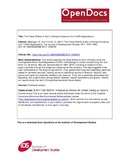The Fiscal Effects of Aid in Ethiopia Evidence from CVAR Applications
| dc.contributor.author | Mascagni, Giulia | |
| dc.contributor.author | Timmis, Emilija | |
| dc.coverage.spatial | Ethiopia | en |
| dc.date.accessioned | 2018-05-01T15:12:30Z | |
| dc.date.available | 2018-05-01T15:12:30Z | |
| dc.date.issued | 2017-01-03 | |
| dc.identifier.citation | Mascagni, G. and Timmis, E. (2017) The Fiscal Effects of Aid in Ethiopia Evidence from CVAR Applications, The Journal of Development Studies, 53:7, 1037-1056, DOI: 10.1080/00220388.2017.1303676 | en |
| dc.identifier.uri | https://opendocs.ids.ac.uk/opendocs/handle/20.500.12413/13701 | |
| dc.description.abstract | This article explores the fiscal effects of aid in Ethiopia using the Cointegrated Vector AutoRegressive (CVAR) methodology to model complex long-run and short-run dynamics. We use national data for 1961–2010, including a measure of aid capturing flows through the budget as measured by the recipient. The data suggests three main conclusions on the long-run equilibrium. First, government long-term spending plans are based on domestic sources, treating aid as an additional source of revenue. Second, both grants and loans are positively related to tax revenue. Third, aid is positively associated with spending, with a particularly strong relation between capital expenditure and grants. Overall, our results show that aid in Ethiopia had beneficial fiscal effects. | en |
| dc.language.iso | en | en |
| dc.publisher | Taylor and Francis | en |
| dc.relation.ispartofseries | The Journal of Development Studies;Vol 53 | |
| dc.rights | © 2017 UNU-WIDER. Published by Informa UK Limited, trading as Taylor & Francis Group. This is an Open Access article distributed under the terms of the Creative Commons Attribution-Non Commercial-No Derivatives License (http://creativecommons.org/licenses/by-nc-nd/4.0/), which permits non-commercial re-use, distribution, and reproduction in any medium, provided the original work is properly cited, and is not altered, transformed, or built upon in any way. | en |
| dc.rights.uri | http://creativecommons.org/licenses/by-nc-nd/4.0/ | en |
| dc.subject | Governance | en |
| dc.title | The Fiscal Effects of Aid in Ethiopia Evidence from CVAR Applications | en |
| dc.type | Article | en |
| dc.rights.holder | Taylor and Francis | en |
| dc.identifier.externaluri | https://www.tandfonline.com/doi/full/10.1080/00220388.2017.1303676 | en |
| dc.identifier.team | Governance | en |
| dc.identifier.doi | 10.1080/00220388.2017.1303676 | |
| dcterms.dateAccepted | 2017-01-03 | |
| rioxxterms.funder | Default funder | en |
| rioxxterms.identifier.project | Default project | en |
| rioxxterms.version | NA | en |
| rioxxterms.funder.project | 9ce4e4dc-26e9-4d78-96e9-15e4dcac0642 | en |
Files in this item
This item appears in the following Collection(s)
Except where otherwise noted, this item's license is described as © 2017 UNU-WIDER. Published by Informa UK Limited, trading as Taylor & Francis Group. This is an Open Access article distributed under the terms of the Creative Commons Attribution-Non Commercial-No Derivatives License (http://creativecommons.org/licenses/by-nc-nd/4.0/), which permits non-commercial re-use, distribution, and reproduction in any medium, provided the original work is properly cited, and is not altered, transformed, or built upon in any way.


